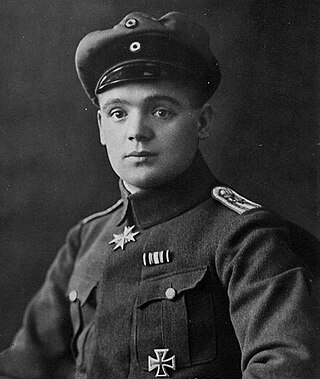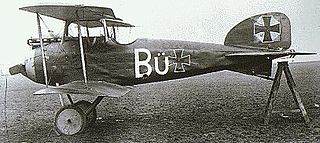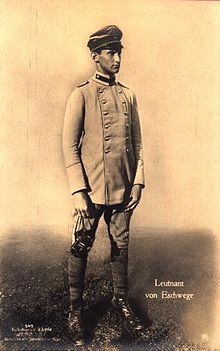This is a list of aviation-related events from 1918:

World War I was the first major conflict involving the large-scale use of aircraft. Tethered observation balloons had already been employed in several wars, and would be used extensively for artillery spotting. Germany employed Zeppelins for reconnaissance over the North Sea and Baltic and also for strategic bombing raids over Britain and the Eastern Front.

Julius Buckler was a German First World War fighter ace credited with 36 victories during the war. He shot down 29 enemy airplanes and seven observation balloons; two other victories went unconfirmed. He was one of only four German fighter aces to win Germany's highest decorations for valor for both enlisted man and officer.

Erich Loewenhardt was a German soldier and military aviator who fought in the First World War and became a fighter ace credited with 54 confirmed aerial victories. Originally enlisting in an infantry regiment even though he was only 17, he fought in the Battle of Tannenberg, winning a battlefield commission on 2 October 1914. He would serve in the Carpathians and on the Italian Front before being medically discharged in mid-1915. Following a five month recuperation, Loewenhardt joined the Imperial German Air Service in 1916. After serving as an aerial observer and reconnaissance pilot, he underwent advanced training to become a fighter pilot with Jagdstaffel 10 in March 1917. Between 24 March 1917 and 10 August 1918, Loewenhardt shot down 45 enemy airplanes, as well as destroying nine observation balloons. Shortly after his final victory, he was killed in a collision with another German pilot.

Michel Joseph Callixte Marie Coiffard was one of the leading French flying aces of World War I. He was notable for his success as a balloon buster shooting down enemy observation balloons, which were usually heavily defended by anti-aircraft machine guns and artillery and by fighter planes. He scored 34 victories in his career.

Heinrich Bongartz PlM, HOH, IC, was a German World War I fighter pilot and flying ace credited with 33 confirmed victories and one unconfirmed. He also served as a night fighter commander in World War II.

Jasta 2 was one of the best-known German Luftstreitkräfte Squadrons in World War I. Its first commanding officer was the great aerial tactician Oswald Boelcke, and it was the incubator of several notable aviation careers.
Oberleutnant Friedrich Ritter von Röth was a German World War I fighter ace with 28 victories. He was the most successful German pilot at the extremely hazardous practice of shooting down enemy observation balloons, and destroyed 20 of them. Röth concentrated on observation balloons because they were large enough targets for him to see and hit with machine gun fire.
Hans Kirschstein, winner of the Pour le Merite, Royal House Order of Hohenzollern, and the Iron Cross, 1st and 2nd class, was a German lieutenant and World War I flying ace credited with 27 aerial victories.
LeutnantMax Näther HOH, IC, was a German World War I ace fighter pilot who destroyed 26 enemy aircraft. He shot down ten observation balloons and sixteen airplanes, including ten SPAD S.XIII fighters and a Sopwith Dolphin. He was killed in his plane at the border of Germany during the Greater Poland uprising on 8 January 1919.

Leutnant Rudolf Friedrich Otto Windisch was a World War I fighter ace credited with 22 victories.
Leutnant Helmut Dilthey IC was a German pilot who became a World War I flying ace credited with seven aerial victories.
Adjutant Paul Armand Petit was a World War I flying ace credited with seven aerial victories, at least four of which were observation balloons.
Hans-Georg von der Marwitz was a German World War I flying ace credited with 15 aerial victories.

OberleutnantHans Berr was a German professional soldier and World War I flying ace. At the start of the First World War, he served in a scout regiment until severely wounded; he then transferred to aviation duty. Once trained as a pilot, he helped pioneer the world's first dedicated fighter airplane, the Fokker Eindekker "flying gun". Flying one, Berr shot down two enemy airplanes in March 1916 as his contribution to the Fokker Scourge. Berr was then chosen to command one of the world's original fighter squadrons, Jagdstaffel 5. Leading his pilots by example, Berr scored eight more victories in a four week span in October - November 1916 while his pilots began to compile their own victories. Hans Berr was awarded Germany's highest military honor, the Pour le Merite, on 4 December 1916. During a 6 April 1917 dogfight, Berr and his wingman mortally collided.
Royal Prussian Jagdstaffel 14 was a "hunting group" of the Luftstreitkräfte, the air arm of the Imperial German Army during World War I. As one of the original German fighter squadrons, the unit would score 57 aerial victories during the war. In turn, the Jasta paid a price of eight killed in action, five wounded in action, and three taken prisoner of war.
Captain Lancelot Lytton Richardson was an Australian flying ace during World War I. He was credited with seven confirmed aerial victories before his death in action on 13 April 1917.
Second Lieutenant Leslie Simpson Court was a British World War I flying ace. He was credited with eight aerial victories, gained while serving as an observer/gunner in No. 25 Squadron, Royal Flying Corps.
Oberst Paul Aue was a World War I flying ace from the Kingdom of Saxony in the German Empire. Partial records of his early aviation career credit him with 10 aerial victories. He would join the nascent Luftwaffe during the 1930s and serve Germany through World War II. He died in a Russian prison camp in 1945.









